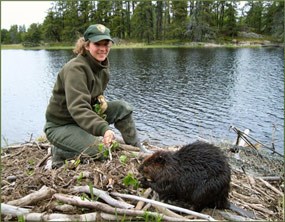
Beavers (Castor canadensis), America’s largest rodent, require water to access food and provide an underwater, predator-proof entrance to their lodges. Beavers are perhaps best known for building dams on streams to create ponds with relatively stable water conditions that they desire. Beavers also live and build lodges in lake environments, such as those that dominate the landscape in Voyageurs National Park. Beavers do not build dams in lakes but instead are subject to natural fluctuations that lakes experience over the course of a year. In the case of the large lakes in Voyageurs National Park, beavers are also subject to unnatural fluctuations that the lakes experience as a result of the manmade dams at International Falls and Kettle Falls. Water levels managed primarily for humans can have dramatic effects on beavers, especially when water levels are drawn down over the winter, a critical period for beaver survival and reproduction. Biologists from Voyageurs National Park have been studying the effects of artificial water level management on aspects of beaver ecology since 2006. Since then, nearly 500 individual beavers have been live-trapped and affixed with uniquely numbered ear tags. Each beaver was carefully measured and weighed to assess body condition (i.e., how fat and healthy are they), age, and sex. Ninety-eight (98) of these beavers were also outfitted with radio transmitters to monitor behavior and survival in relation to winter drawdowns. Results from this research will be used to evaluate water level management strategies put in place in 2000 to reduce negative impacts to Voyageurs National Park aquatic ecosystems.For more information contact: Dr. Steve WindelsTerrestrial Ecologist Voyageurs National Park e-mail us Phone: 218-283-6692 A Description of VNP Beaver Project (2006-2009) and Recovery of Tagged Beavers Voyageurs National Park initiated a project in 2006 to study the effects of the 2000 Rule Curves on beavers in Rainy Lake and the Namakan Reservoir. Since 2006, more than 490 individual beavers have been captured in live traps and fitted with a set of metal numbered ear tags. Nine of these tagged beavers have been legally trapped by fur trappers and reported to us at Voyageurs National Park: seven females and two males. Three of the beavers dispersed before their 2nd birthday. The other six likely dispersed between their 2nd and 3rd birthday. We can only speculate on when they dispersed and the particular route they may have taken to get there as we only know when and where they were tagged and when and where they were subsequently killed. Recovery of tagged beavers by fur trappers provides some interesting information that is outside of the original purpose of the study. They obviously can tell us how far dispersing beavers can travel. Like many mammal species, beavers naturally disperse from the lodge where they were born in their 2nd or 3rd year to find mates and establish their own colonies. Other studies of beavers have shown that beavers will travel up to 11 miles during such events, including sometimes traveling away from the water to cross between stream drainages. We have now documented several examples of beavers traveling much farther than that, with the longest event in excess of 37 miles. One reason why beavers may be dispersing farther than other places beavers have been studied is related to the connectedness of our lake systems here. Essentially, it might simply be easier for a beaver to disperse 30-50 miles from where it was born because they can swim that far without having to ever get out of the water. Beavers are very vulnerable to predators when they are on land and they avoid it when they can. In stream systems, beavers can only travel where the water goes unless they want to cross overland. In a large, connected lake system like we have in the Borderland, beavers have greater options in where they want to go. Trappers are encouraged to contact Steve Windels, Voyageurs National Park, if they harvest a beaver with one or two ear tags.Phone: 218-283-6692 e-mail us |
Last updated: April 10, 2015
